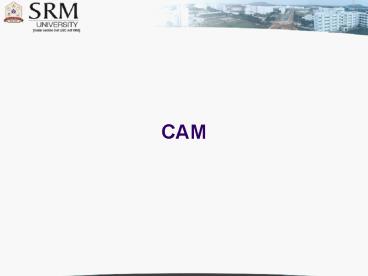CAM - PowerPoint PPT Presentation
1 / 34
Title:
CAM
Description:
CAM 1.1 CAM - Definition Cams are used to convert rotary motion into reciprocating motion Examples for cam In IC engines to operate the inlet and exhaust valves 1.2 ... – PowerPoint PPT presentation
Number of Views:1212
Avg rating:3.0/5.0
Title: CAM
1
CAM
2
1.1 CAM - Definition
- Cams are used to convert rotary motion into
reciprocating motion
3
Examples for cam
- In IC engines to operate the inlet and exhaust
valves
4
1.2 Classification of CAM Mechanism
- Based on modes of Input / Output motion
- 1.2.1 Rotating cam Translating follower
- 1.2.2 Rotating cam Oscillating follower
- 1.2.3 Translating cam Translating follower
5
1.2.1 Rotating cam Translating follower
6
1.2.2 Rotating cam oscillating follower
7
1.2.3 Translating cam Translating follower
8
1.3 Classification of followers
- 1.3.1 According to the shape of follower
- Knife edge follower
- Roller follower
- Flat faced follower
- Spherical faced follower
9
a) Knife edge follower
10
b) Roller follower
11
c) Flat faced follower
12
d) Spherical faced follower
13
1.3.2 According to the path of motion of follower
- Radial follower
- Offset follower
14
a) Radial follower
- When the motion of the follower is along an axis
passing through the centre of the cam, it is
known as radial followers. Above figures are
examples of this type.
15
b) Offset follower
- When the motion of the follower is along an
axis away from the axis of the cam centre, it is
called off-set follower. Above figures are
examples of this type.
16
1.4 Classification of cams
- a) Radial or disc cam
- b) Cylindrical cam
- c) End cam
17
a) Radial or Disc cam
- In radial cams, the follower reciprocates or
oscillates in a direction perpendicular to the
cam axis.
18
b) Cylindrical cams
- In cylindrical cams, the follower reciprocates
or oscillates in a direction parallel to the cams
axis.
19
c) End cams
- It is also similar to cylindrical cams, but
the follower makes contact at periphery of the
cam as shown in fig
20
2. CAM Nomenclature
- Cam profile The outer surface of the disc cam.
- Base circle The circle with the shortest radius
from the cam center to any part of the cam
profile. - Trace point It is a point on the follower, and
its motion describes the movement of the
follower. It is used to generate the pitch curve.
21
2. CAM Nomenclature
- Pitch curve The path generated by the trace
point as the follower is rotated about a
stationery cam. - Prime circle The smallest circle from the cam
center through the pitch curve
22
2. CAM Nomenclature
- Pressure angle The angle between the direction
of the follower movement and the normal to the
pitch curve. - Pitch point Pitch point corresponds to the point
of maximum pressure angle.
23
2. CAM Nomenclature
- Pitch circle A circle drawn from the cam center
and passes through the pitch point is called
Pitch circle - Stroke The greatest distance or angle through
which the follower moves or rotates
24
3. Motion of the follower
- As the cam rotates the follower moves upward
and downward. - The upward movement of follower is called rise
(Outstroke) - The downward movement is called fall
(Returnstroke). - When the follower is not moving upward and
downward even when the cam rotates, it is called
dwell.
25
3.1 Types of follower motion
- Uniform motion ( constant velocity)
- Simple harmonic motion
- Uniform acceleration and retardation motion
- Cycloidal motion
26
a) Uniform motion (constant velocity)
- Displacement diagram Displacement is the
distance that a follower moves during one
complete revolution (or cycle) of the cam while
the follower is in contact with the cam. - It is the plot of linear displacement (s) of
follower V/S angular displacement (?) of the cam
for one full rotation of the cam. - A period is a part of the cam cycle and it
includes the following - Rise (Outstroke) the upward motion of the
follower caused by cam motion. - Fall (Return stroke) the downward motion of the
follower caused by cam motion. - Dwell the stationary position of the follower
caused by cam motion.
27
a) Uniform motion (constant velocity)
28
a) Uniform motion (constant velocity)
- Displacement diagram
- Since the follower moves with uniform velocity
during its rise and fall, the slope of the
displacement curve must be constant as shown in
fig
29
b) Simple Harmonic motion
30
b) Simple harmonic motion
- Since the follower moves with a simple harmonic
motion, therefore velocity diagram consists of a
sine curve and the acceleration diagram consists
of a cosine curve.
31
c) Uniform acceleration and retardation
- Since the acceleration and retardation are
uniform, therefore the velocity varies directly
with time.
32
d) Cycloidal motion
33
CAM Profile
34
References
- www.geocities.com
- www. nptel.iitm.ac.in
- www.ul.ie

